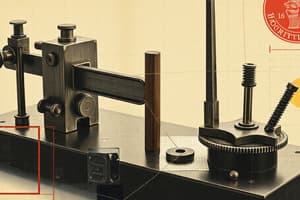Podcast
Questions and Answers
What is a lever?
What is a lever?
A lever is a beam on a fulcrum.
Where is the force transmitted?
Where is the force transmitted?
The force is transmitted across a length around another point.
What is the benefit of a lever?
What is the benefit of a lever?
The benefit of a lever is that less force is required to move an object with more mass.
What are the three types of levers?
What are the three types of levers?
Describe a first class lever.
Describe a first class lever.
Where is the fulcrum in a first class lever?
Where is the fulcrum in a first class lever?
Give an application of a first class lever.
Give an application of a first class lever.
Describe a second class lever.
Describe a second class lever.
Where is the fulcrum in a second class lever?
Where is the fulcrum in a second class lever?
Give an application of a second class lever.
Give an application of a second class lever.
Describe a third class lever.
Describe a third class lever.
Where is the fulcrum in a third class lever?
Where is the fulcrum in a third class lever?
Give an application of a third class lever.
Give an application of a third class lever.
What is torque?
What is torque?
What is another name for torque?
What is another name for torque?
What is the formula for torque?
What is the formula for torque?
What are the names of the variables used in the formula for torque?
What are the names of the variables used in the formula for torque?
What are the units used in torque?
What are the units used in torque?
Mechanic pulls on a 6-inch wrench with a force of 100 lbs. What is the torque?
Mechanic pulls on a 6-inch wrench with a force of 100 lbs. What is the torque?
What is mechanical advantage?
What is mechanical advantage?
What is the formula for mechanical advantage?
What is the formula for mechanical advantage?
Which class lever has little to no mechanical advantage?
Which class lever has little to no mechanical advantage?
Define the Law of Moments.
Define the Law of Moments.
What is the formula for the Law of Moments?
What is the formula for the Law of Moments?
Define each variable in the Law of Moments.
Define each variable in the Law of Moments.
Flashcards are hidden until you start studying
Study Notes
Levers Overview
- A lever consists of a beam supported by a fulcrum to transmit force across a length around a pivot point.
- Levers require less force to move heavier objects, enhancing mechanical efficiency.
Types of Levers
- There are three classes of levers: first class, second class, and third class.
First Class Lever
- The fulcrum is positioned between the effort force and the resistance, allowing flexibility in force distances.
- Common examples include scissors and crowbars.
Second Class Lever
- The resistance force is located between the effort force and the fulcrum, which is at one end.
- A notable application is the wheelbarrow, where effort applied makes lifting easier.
Third Class Lever
- The effort force is positioned between the fulcrum and the resistance force, generally leading to less mechanical advantage.
- Cranes exemplify this class, requiring greater input force for the output achieved.
Torque
- Torque represents the tendency of a force to cause rotation around an axis, also known as the moment of force.
- The formula for torque is T = F x d, where T is torque, F is force, and d is the distance from the fulcrum to the point of application.
Mechanical Advantage
- Mechanical advantage (MA) measures the effectiveness of the lever, defined as the ratio of output force to input force.
- Its formula is MA = LE / LR, where LE is effort length and LR is resistance length.
- First class levers can have mechanical advantages of up to 2, while third class levers typically have a mechanical advantage of about 0.25.
Law of Moments
- The Law of Moments states that for a lever to be in rotational equilibrium, the effort moment must equal or exceed the resistance moment.
- The formula is FE x LE = FR x LR, where FE is effort force, LE is effort length, FR is resistance force, and LR is resistance length.
Variables for Law of Moments
- FE: Effort Force
- LE: Effort Length
- FR: Resistance Force
- LR: Resistance Length
- ME: Effort Moment
- MR: Resistance Moment
Studying That Suits You
Use AI to generate personalized quizzes and flashcards to suit your learning preferences.




